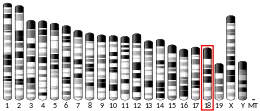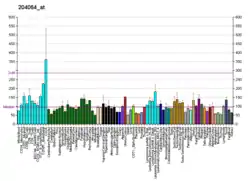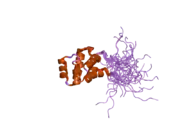THO complex subunit 1 is a protein that in humans is encoded by the THOC1 gene.[5][6]
HPR1 is part of the TREX (transcription/export) complex, which includes TEX1 (MIM 606929), THO2 (MIM 300395), ALY (MIM 604171), and UAP56 (MIM 606390).[supplied by OMIM][6]
Interactions
THOC1 has been shown to interact with Retinoblastoma protein.[7]
References
- 1 2 3 GRCh38: Ensembl release 89: ENSG00000079134 - Ensembl, May 2017
- 1 2 3 GRCm38: Ensembl release 89: ENSMUSG00000024287 - Ensembl, May 2017
- ↑ "Human PubMed Reference:". National Center for Biotechnology Information, U.S. National Library of Medicine.
- ↑ "Mouse PubMed Reference:". National Center for Biotechnology Information, U.S. National Library of Medicine.
- ↑ Strasser K, Masuda S, Mason P, Pfannstiel J, Oppizzi M, Rodriguez-Navarro S, Rondon AG, Aguilera A, Struhl K, Reed R, Hurt E (May 2002). "TREX is a conserved complex coupling transcription with messenger RNA export". Nature. 417 (6886): 304–8. Bibcode:2002Natur.417..304S. doi:10.1038/nature746. PMID 11979277. S2CID 1112194.
- 1 2 "Entrez Gene: THOC1 THO complex 1".
- ↑ Durfee, T; Mancini M A; Jones D; Elledge S J; Lee W H (November 1994). "The amino-terminal region of the retinoblastoma gene product binds a novel nuclear matrix protein that co-localizes to centers for RNA processing". J. Cell Biol. 127 (3): 609–22. doi:10.1083/jcb.127.3.609. ISSN 0021-9525. PMC 2120229. PMID 7525595.
Further reading
- Durfee T, Mancini MA, Jones D, et al. (1994). "The amino-terminal region of the retinoblastoma gene product binds a novel nuclear matrix protein that co-localizes to centers for RNA processing". J. Cell Biol. 127 (3): 609–22. doi:10.1083/jcb.127.3.609. PMC 2120229. PMID 7525595.
- Maruyama K, Sugano S (1994). "Oligo-capping: a simple method to replace the cap structure of eukaryotic mRNAs with oligoribonucleotides". Gene. 138 (1–2): 171–4. doi:10.1016/0378-1119(94)90802-8. PMID 8125298.
- Suzuki Y, Yoshitomo-Nakagawa K, Maruyama K, et al. (1997). "Construction and characterization of a full length-enriched and a 5'-end-enriched cDNA library". Gene. 200 (1–2): 149–56. doi:10.1016/S0378-1119(97)00411-3. PMID 9373149.
- Strausberg RL, Feingold EA, Grouse LH, et al. (2003). "Generation and initial analysis of more than 15,000 full-length human and mouse cDNA sequences". Proc. Natl. Acad. Sci. U.S.A. 99 (26): 16899–903. Bibcode:2002PNAS...9916899M. doi:10.1073/pnas.242603899. PMC 139241. PMID 12477932.
- Ota T, Suzuki Y, Nishikawa T, et al. (2004). "Complete sequencing and characterization of 21,243 full-length human cDNAs". Nat. Genet. 36 (1): 40–5. doi:10.1038/ng1285. PMID 14702039.
- Dennehey BK, Gutches DG, McConkey EH, Krauter KS (2004). "Inversion, duplication, and changes in gene context are associated with human chromosome 18 evolution". Genomics. 83 (3): 493–501. doi:10.1016/j.ygeno.2003.08.017. PMID 14962675.
- Beausoleil SA, Jedrychowski M, Schwartz D, et al. (2004). "Large-scale characterization of HeLa cell nuclear phosphoproteins". Proc. Natl. Acad. Sci. U.S.A. 101 (33): 12130–5. Bibcode:2004PNAS..10112130B. doi:10.1073/pnas.0404720101. PMC 514446. PMID 15302935.
- Gasparri F, Sola F, Locatelli G, Muzio M (2004). "The death domain protein p84N5, but not the short isoform p84N5s, is cell cycle-regulated and shuttles between the nucleus and the cytoplasm". FEBS Lett. 574 (1–3): 13–9. doi:10.1016/j.febslet.2004.07.074. PMID 15358532. S2CID 43023236.
- Gerhard DS, Wagner L, Feingold EA, et al. (2004). "The status, quality, and expansion of the NIH full-length cDNA project: the Mammalian Gene Collection (MGC)". Genome Res. 14 (10B): 2121–7. doi:10.1101/gr.2596504. PMC 528928. PMID 15489334.
- Li Y, Wang X, Zhang X, Goodrich DW (2005). "Human hHpr1/p84/Thoc1 regulates transcriptional elongation and physically links RNA polymerase II and RNA processing factors". Mol. Cell. Biol. 25 (10): 4023–33. doi:10.1128/MCB.25.10.4023-4033.2005. PMC 1087710. PMID 15870275.
- Masuda S, Das R, Cheng H, et al. (2005). "Recruitment of the human TREX complex to mRNA during splicing". Genes Dev. 19 (13): 1512–7. doi:10.1101/gad.1302205. PMC 1172058. PMID 15998806.
- Rual JF, Venkatesan K, Hao T, et al. (2005). "Towards a proteome-scale map of the human protein-protein interaction network". Nature. 437 (7062): 1173–8. Bibcode:2005Natur.437.1173R. doi:10.1038/nature04209. PMID 16189514. S2CID 4427026.
- Kimura K, Wakamatsu A, Suzuki Y, et al. (2006). "Diversification of transcriptional modulation: large-scale identification and characterization of putative alternative promoters of human genes". Genome Res. 16 (1): 55–65. doi:10.1101/gr.4039406. PMC 1356129. PMID 16344560.
- Olsen JV, Blagoev B, Gnad F, et al. (2006). "Global, in vivo, and site-specific phosphorylation dynamics in signaling networks". Cell. 127 (3): 635–48. doi:10.1016/j.cell.2006.09.026. PMID 17081983. S2CID 7827573.
- Li Y, Lin AW, Zhang X, et al. (2007). "Cancer cells and normal cells differ in their requirements for Thoc1". Cancer Res. 67 (14): 6657–64. doi:10.1158/0008-5472.CAN-06-3234. PMC 2804983. PMID 17638875.
- Garner E, Martinon F, Tschopp J, et al. (2007). "Cells with defective p53-p21-pRb pathway are susceptible to apoptosis induced by p84N5 via caspase-6". Cancer Res. 67 (16): 7631–7. doi:10.1158/0008-5472.CAN-07-0334. PMID 17699767.
This article is issued from Wikipedia. The text is licensed under Creative Commons - Attribution - Sharealike. Additional terms may apply for the media files.






